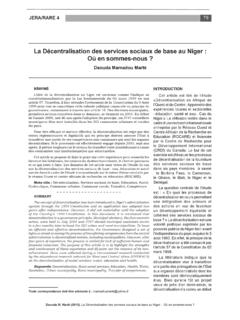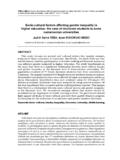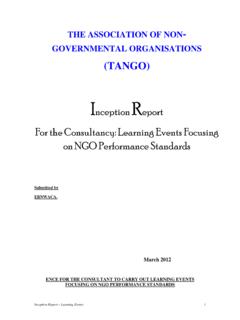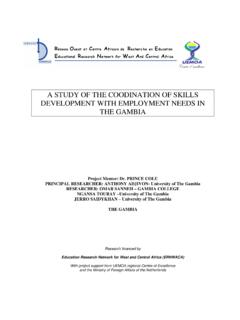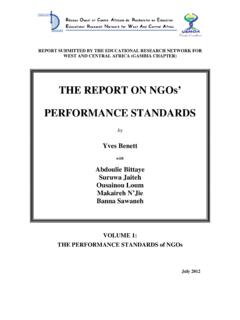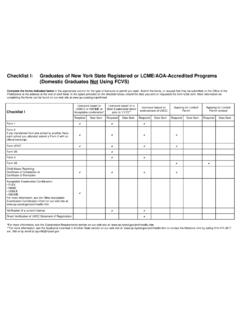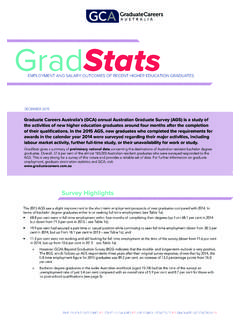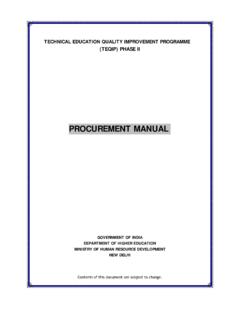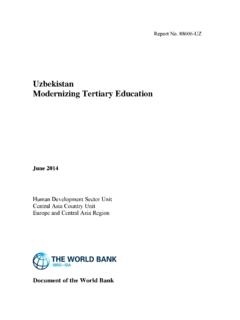Transcription of NTA TRACER STUDY OF TECHNICAL VOCATIONAL …
1 NTA TRACER STUDY OF TECHNICAL VOCATIONAL education GRADUATES report SUBMITTED by ERNWACA December 2013 i CONTENTS page Acknowledgements iii Acronyms iv Executive Summary V CHAPTER 1: INTRODUCTION AND BACKGROUND 1 Earlier developments and current state of TVET in The Gambia 1 CHAPTER 2: THE AIMS AND OBJECTIVES AND SCOPE OF WORK OF THE TRACER STUDY OF TVET GRADUATES 4 CHAPTER 3: METHODOLOGY 5 Desk Review 5 Consultation and Interview 5 Research Approach 5 Target Group 6 Sample Frame and Size 6 Sample Frame 7 Sample Size Determination 7 Selection Procedures 7 Design of Questionnaires and Data Collection 8 Pilot Testing 8 Data Collection 8 Data Processing 9 Data Analysis including SWOT 9 Limitations and Constraints 9 CHAPTER 4.
2 SPECIFIC RESULT OF THE TRACER AND ASSESSMENT STUDY OF TVET GRADUATES 2009 TO 2011 10 Introduction 10 Response Rate 10 Analysis of the result of TVET Graduates (2009-2011) Performance 10 Profile of 2009 -2011 TVET Graduates Distribution of TVET Graduates by LGA of residence, LGA of birth, age group, Type of course and gender 10 Distribution of TVET graduates by duration of course, mode of attendance, year of completion, disability status and gender 15 Distribution of TVET graduates by employment status and course/programme attended, duration of course, year of completion, disability status, education level before TVET training, and gender 17 Distribution of employed TVET graduates by opinion on relevance, adequacy of TVET training for their jobs by gender. 21 Distribution of employed TVET graduates by opinion on the adequacy of the practical aspect of their TVET training by gender 23 Distribution of unemployed TVET graduates by difficulties to secure employment 24 Distribution of unemployed TVET graduates by difficulties to secure self- employment, 25 Distribution of TVET graduates by employment status and opinion on availability of jobs in their residential area 25 Number of graduates interviewed who had to change subject area studied in TVET 26 ii Institution Job situation of TVET graduates interviewed 27 The need for guidance and counselling of students before the commencement of the course 30 Employment status of Graduates interviewed and the type of employment (paid or self employed)
3 , employment status and by type of organisation, employed 32 Time-lag for graduates to get present job after TVET training and by gender 34 The social effects of employment or unemployment on TVET graduates interviewed 35 Distribution of employed TVET graduates by opinion on relevance, adequacy and practical aspect of TVET training for their jobs by course attended 38 Distribution of employed TVET graduates by level of monthly salary and level of satisfaction therein 43 CHAPTER 5: EMPLOYERS OF TVET GRADUATES 2009-2011 44 Profile of employers employing TVET graduates 2009-2011 44 Employers level of satisfaction with skills and performance of the 2009 2011 TVET graduates 45 Distribution of employers of TVET graduates by type of enterprise and level of satisfaction on skills, performance of employed TVET graduates 45 Distribution of employers of TVET graduates by opinion on the quality and relevance of specific courses offered at TVET training institutions 49 Type of qualification and skills preferred by employers of TVET graduates 50 CHAPTER 6.
4 TVET TRAINING PROVIDERS 52 Profile of TVET Training Providers 52 TVET training institutions curriculum for each skill area 53 Labour market research 53 Linkages between TVET training institutions and industry 54 Quality assurance system in TVET training institutions 55 Assessment and monitoring of TVET training institutions 56 Career guidance and counseling 56 Assessment of The Capacity of TVET Training Providers 57 CHAPTER 7: SUMMARY OF SPECIFIC AND GENERAL FINDINGS OF THE TVET TRACER STUDY 59 Major specific findings TVET TRACER STUDY 59 Summary of general finding of the TRACER of TVET graduates 61 Effectiveness and Relevance of Training to Job Market 61 Adequacy of Training to Present Jobs of Graduates 61 Quality Assurance System 62 Enhancing Training Programmes and Services of TVET Providers 62 On Innovation Regarding TVET 62 Network improvement between Providers and Industries 62 Standards and Qualification 62 CHAPTER 8: CONCLUSION 63 CHAPTER 9: RECOMMENDATION 64 References 68 APPENDIX 1.
5 Distribution of Graduates Interviewed by TVET Institutions attended 69 APPENDIX II QUESTIONNAIRES 71 iii Acknowledgements The Gambia Chapter of the Educational Research Network for West and Central Africa (ERNWACA) wishes to thank the National Training Authority (NTA) and its Staff for the support and participation which they provided for during the planning and implementation of this important project. Our thanks also go to the Ministry of Trade Industry Regional Integration and Employment and United Nations Development Programme(UNDP) for providing financial support for the consultancy. We wish to acknowledge the efficient professional services provided for by our associate consultants Mr. Abdoulie O. Bittaye, Mr Abdou Njie and Mr. Idi Ceesay Our thanks go to all the Enumerators, Supervisors, Employers of TVET graduates, Training providers for the administration of the research instruments.
6 Many thanks to Haddy Sillah and Mariama Keita for providing an efficient an excellent secretarial Mr. Njie (National Co-ordinator ERNWACA Chapter) iv Acronyms CRR - Central River Region CSPRO - Census and Survey Programme ERNWACA - Educational Research Network for West and Central Africa GBA - Greater Banjul Area GBOS - Gambia Bureau of Statistics GDP - Gross Domestic Product GoG - Government of Gambia GSQF - Gambia Skills Qualification Framework GTTI - Gambia TECHNICAL Training Institute IT - Information Technology LGA - Local Government Area LMIS - Labour Market Information System MoHERST - Ministry of Higher education .
7 Research Science and Technology NEAP - National Employment Action Programme NYSS - National Youths Service Scheme NVQ - National VOCATIONAL Qualification NTA - National Training Authority PAGE - Programme for Accelerated Growth and Employment SPSS - Statistical Package for Social Science SWOT - Strengths Weaknesses Opportunities Threat ToR - Terms of Reference TVET - TECHNICAL VOCATIONAL education Training UNDP - United Nation Development Programme v EXECUTIVE SUMMARY One of the Major challenges facing The Gambia is the provision of a pool of well trained skilled artisans and technicians to meet the requirements of the country s socio-economic development activities.
8 In the last three decades, The Gambia Government developed VOCATIONAL and skills training programmes as integral parts of broader strategies to promote development and employment. Many of the TVET training providers both in the public and private sectors have been producing graduates in various occupational areas and there has never been any comprehensive TRACER STUDY conducted on TVET graduates countrywide. Some of the TRACER studies conducted were limited to the graduates of specific training institutions. The NTA in collaboration with the Ministry of Trade, Industry, Regional Integration and Employment saw the need to carry out a comprehensive TRACER STUDY of TVET graduates to assess the relevance and impact of current courses in meeting the labour market needs and the success of training providers in preparing trainees adequately for the job market.
9 The NTA with funding from the United Nations Development Programme (UNDP) decided to engage the service of a consultant to undertake the assessment of the TECHNICAL VOCATIONAL education and Training programmes conducted by TVET training providers. THE AIMS The aim of this TVET TRACER STUDY of TVET Graduates was to determine the outcomes of TVET training provided to trainees in terms of relevant skills necessary for their entry into the job market. The data, information, findings, and recommendations of the STUDY will hopefully help to enhance the development of the TVET system, especially in the area of quality assurance control and delivery. THE METHODOLOGY The TRACER STUDY of TVET graduates and the assessment of the current courses in meeting the labour market needs was based on the following: i.
10 Literature review of existing relevant reports and documents on the TVET system and empirical studies. ii. Consultation with key informants and stakeholders. iii. Field survey/interviews of representative sample of graduates, employers and training providers, using the retrospective approach for employers of the TVET graduates and training providers respectively. THE ACHIEVED SAMPLES AND DATA COLLECTION PROCEDURES For the retrospect approach, 1314 TVET graduates was the sample size for (2009 2011). However out of this target 1073 were interviewed. giving a response rate of percent. A random sample of 34 employers of the TVET graduates for the period concerned were also interviewed for their views on the level of satisfaction with regard to TVET graduates skills and performance level, on the job, whilst another random sample of 73 TVET training institutions were selected based on the list provided by NTA.

